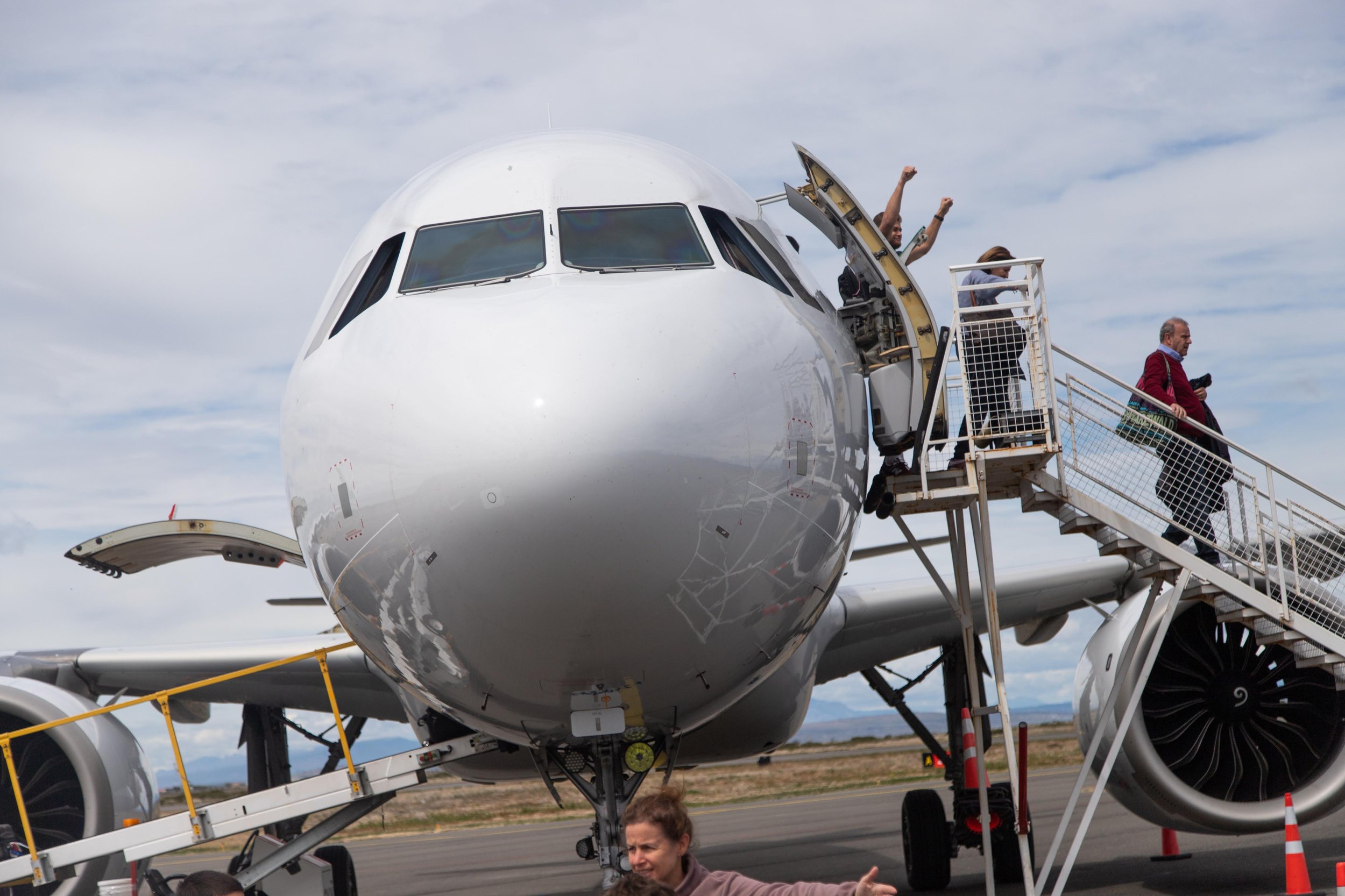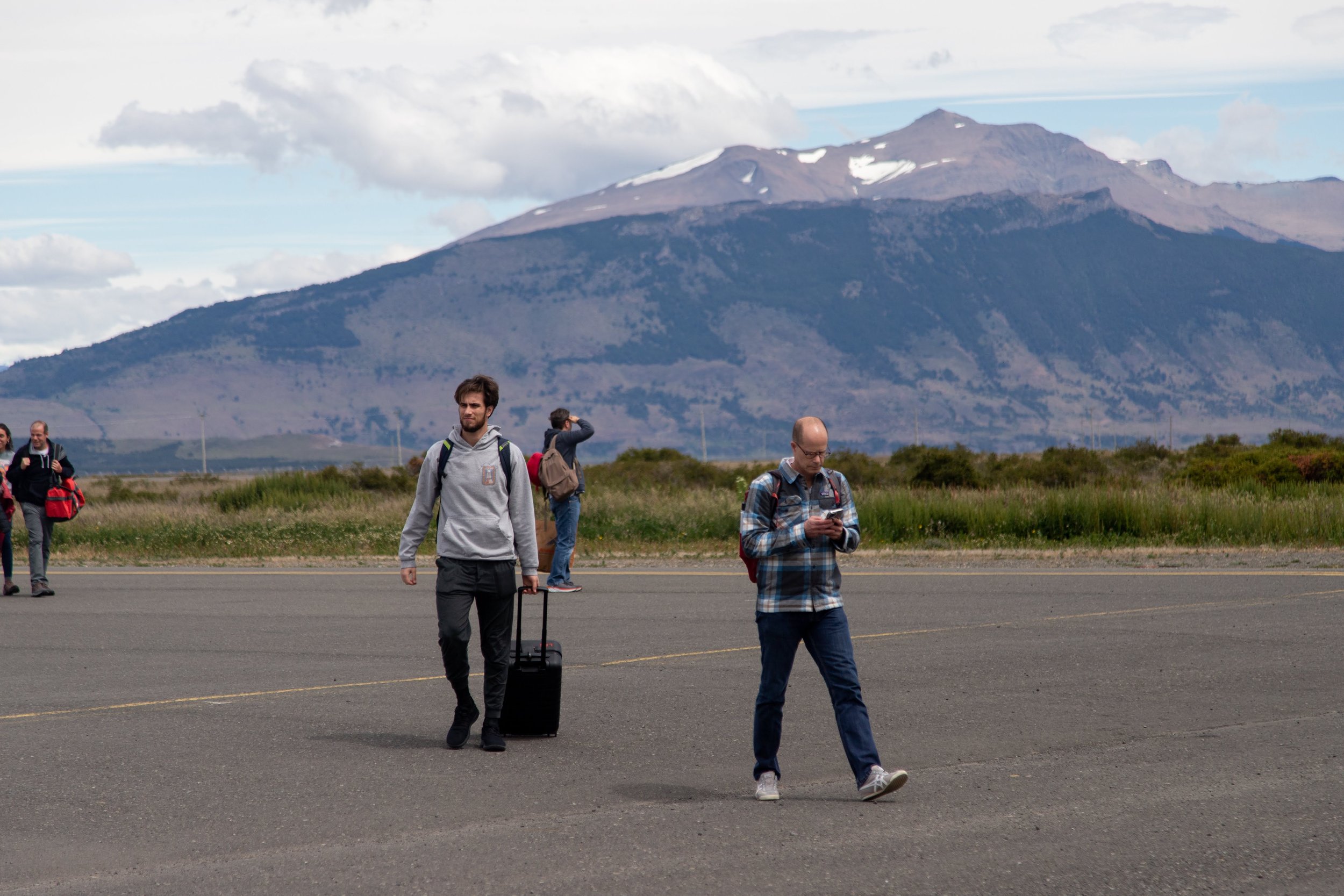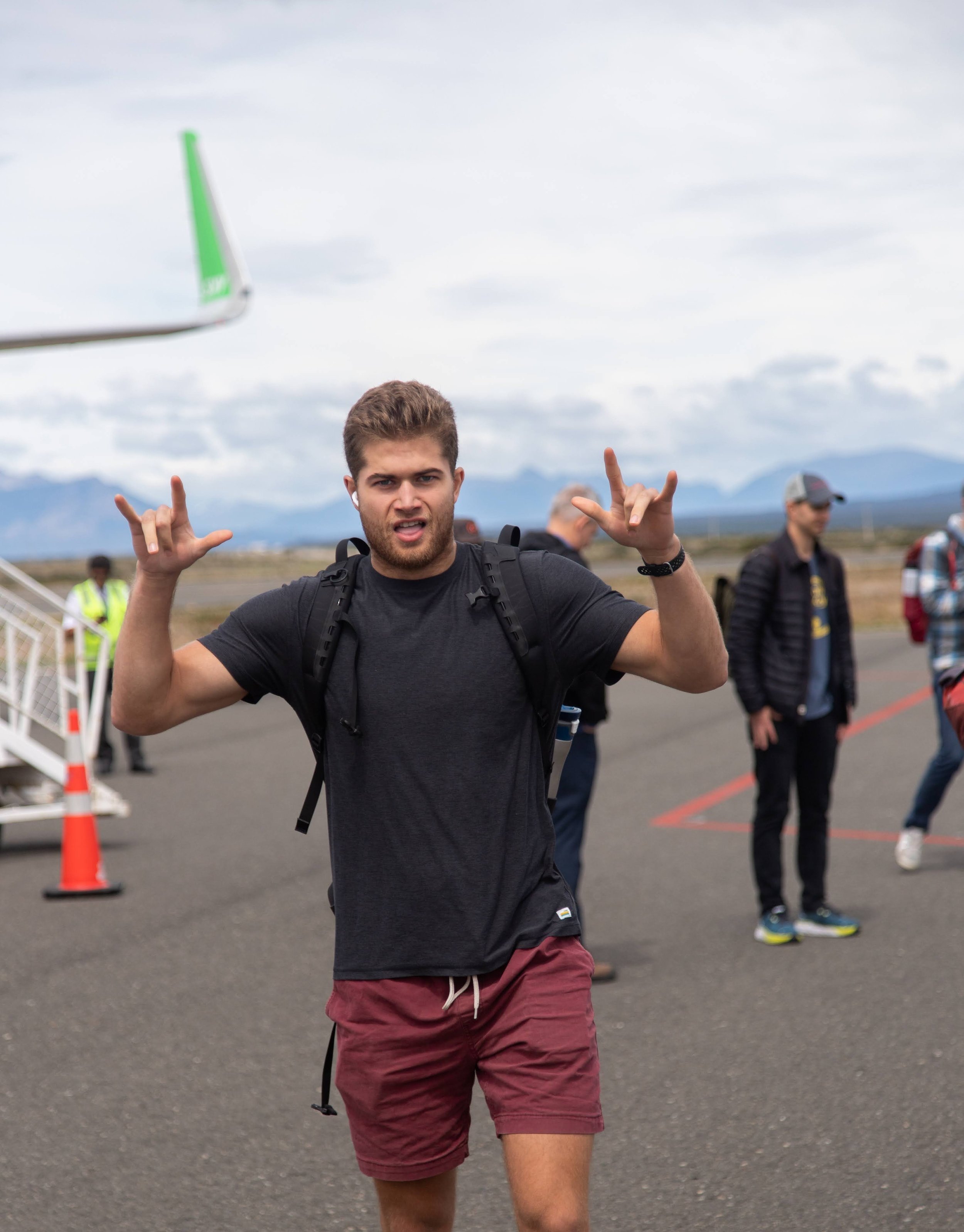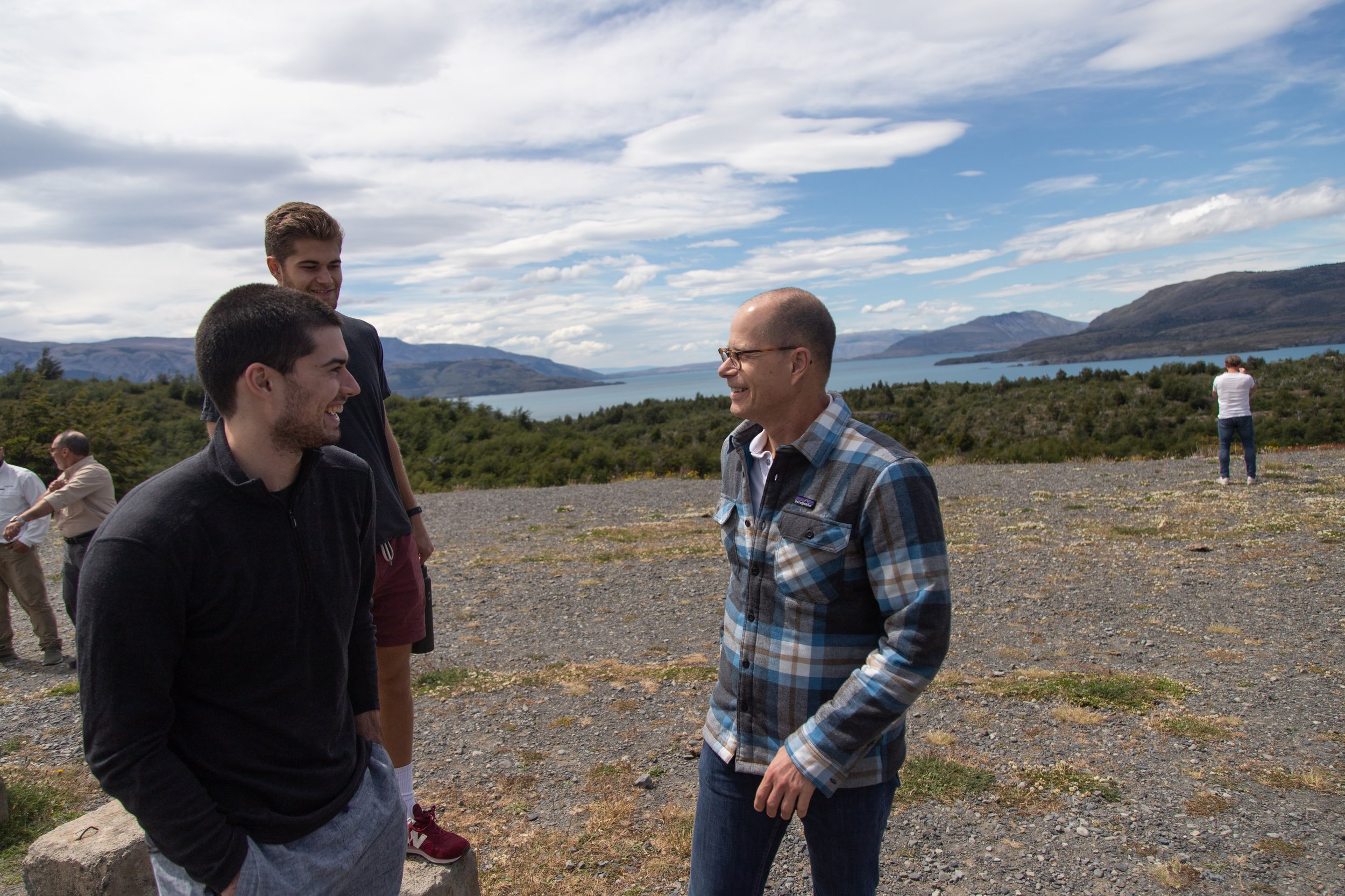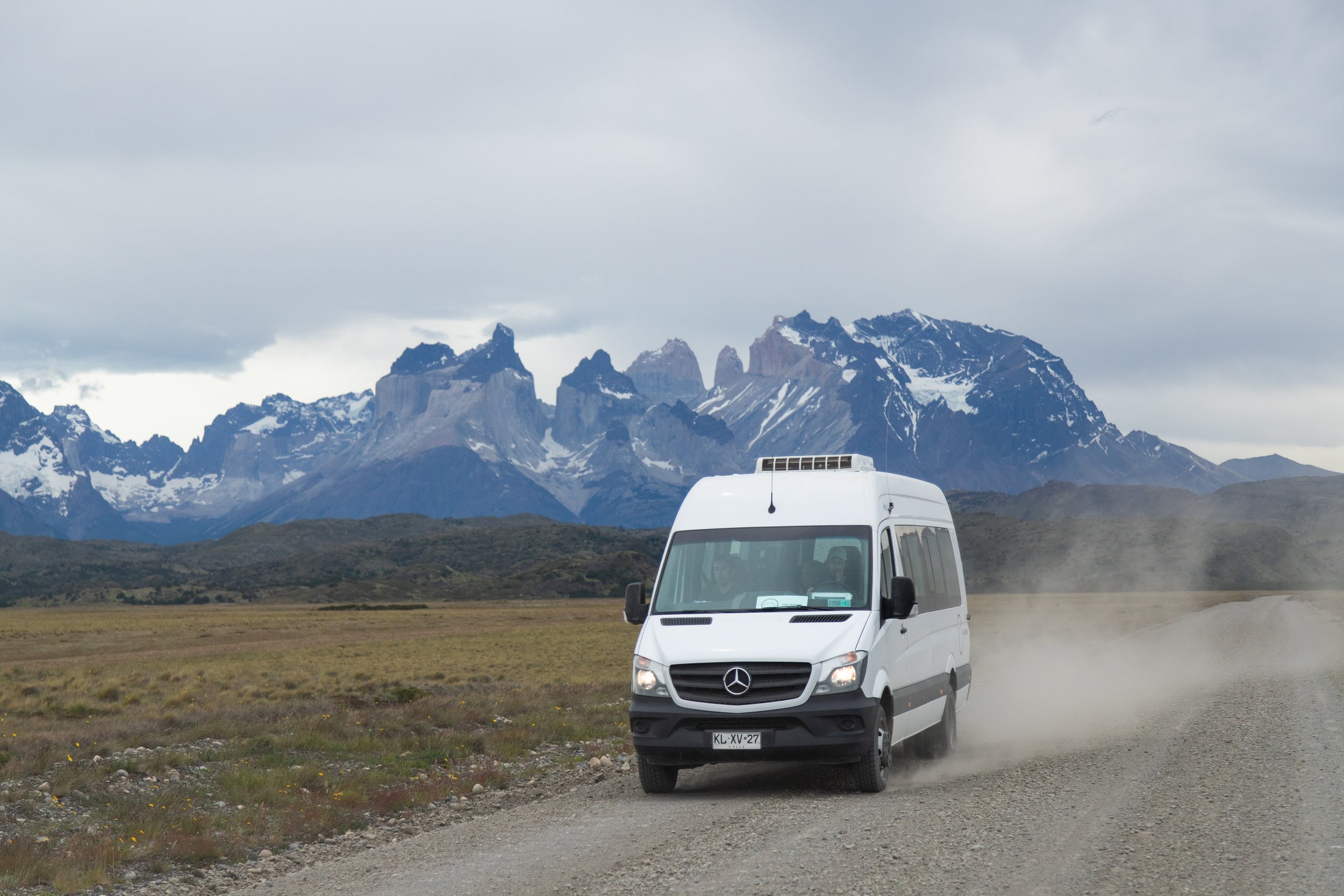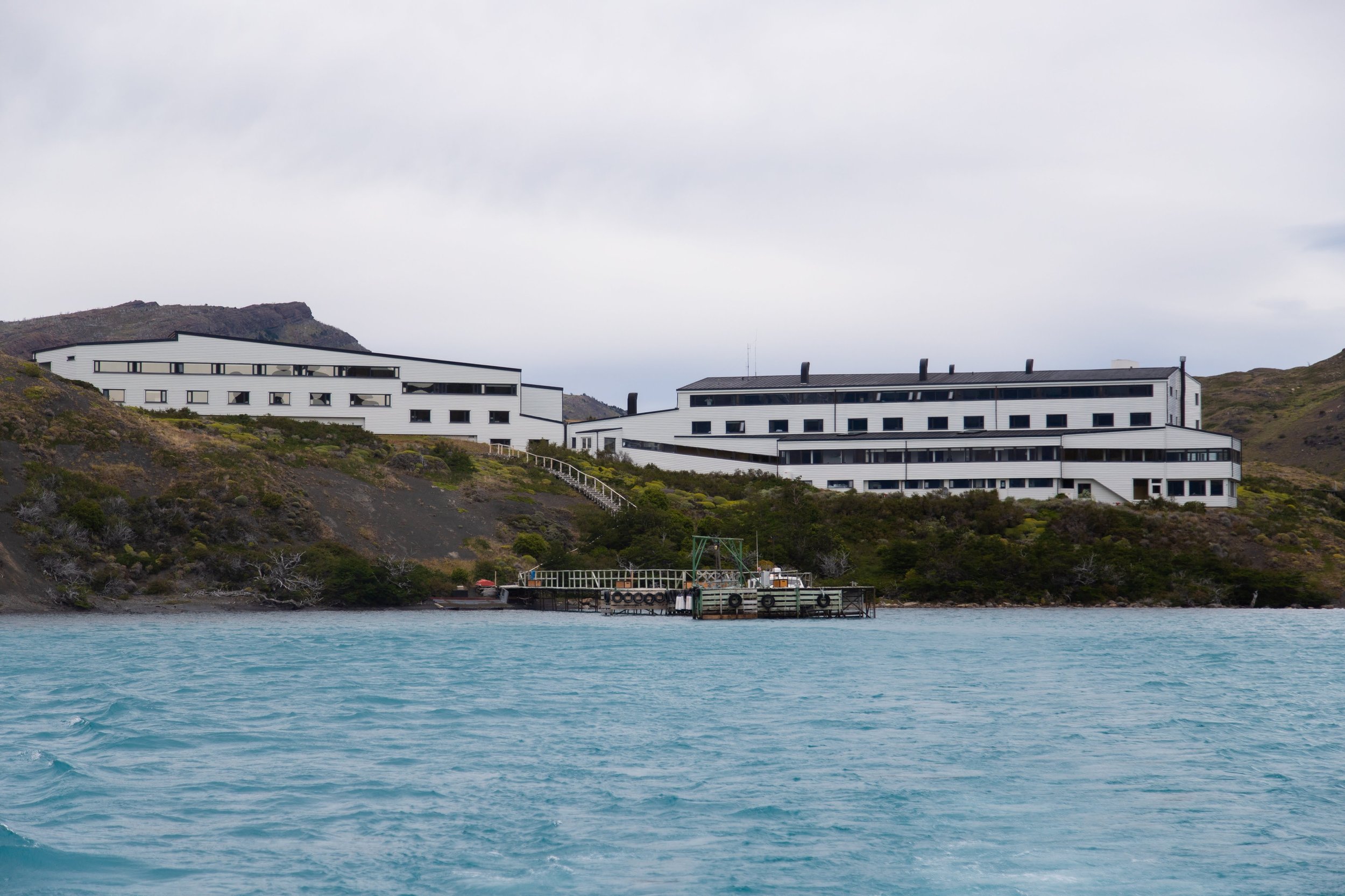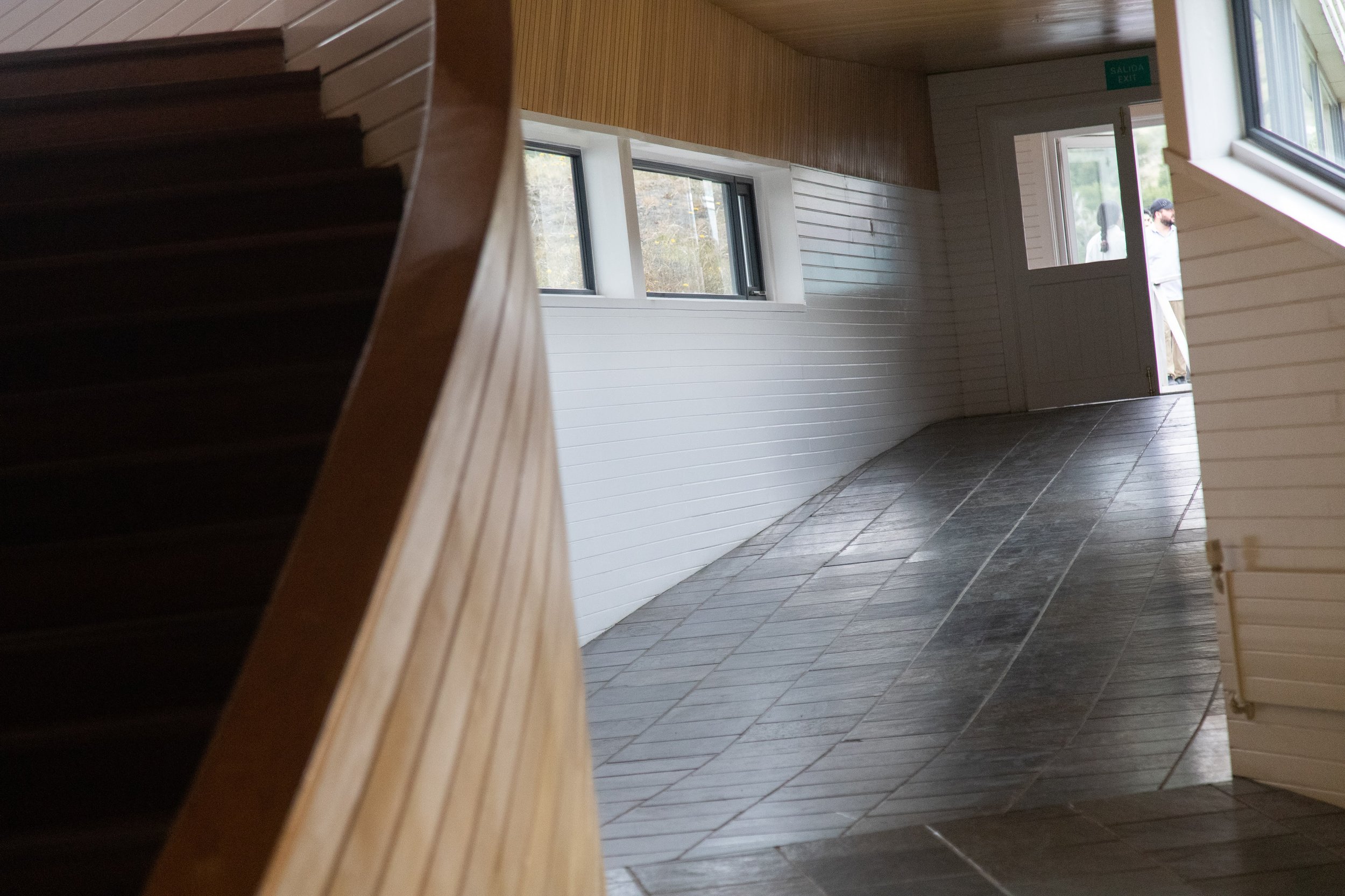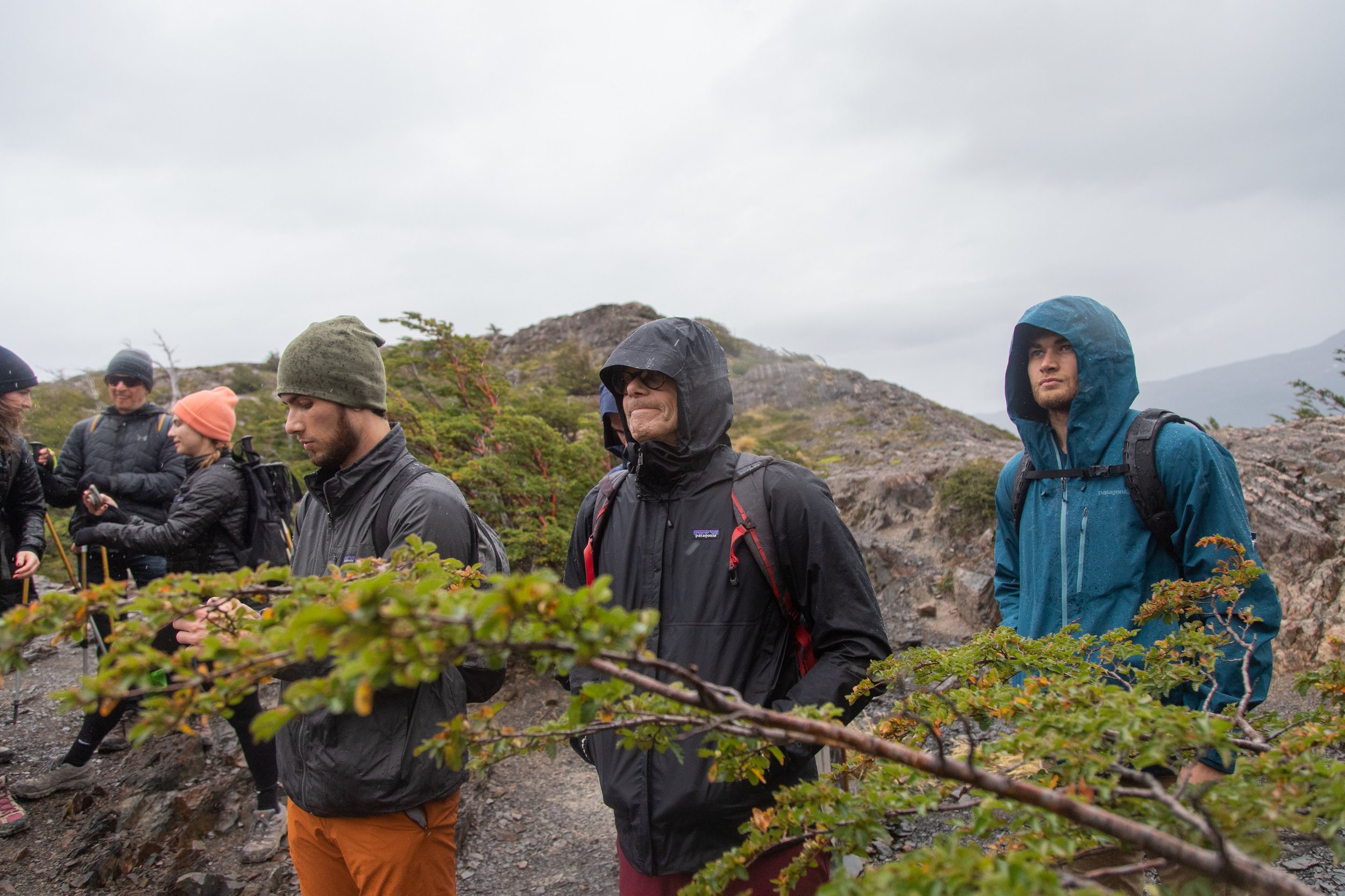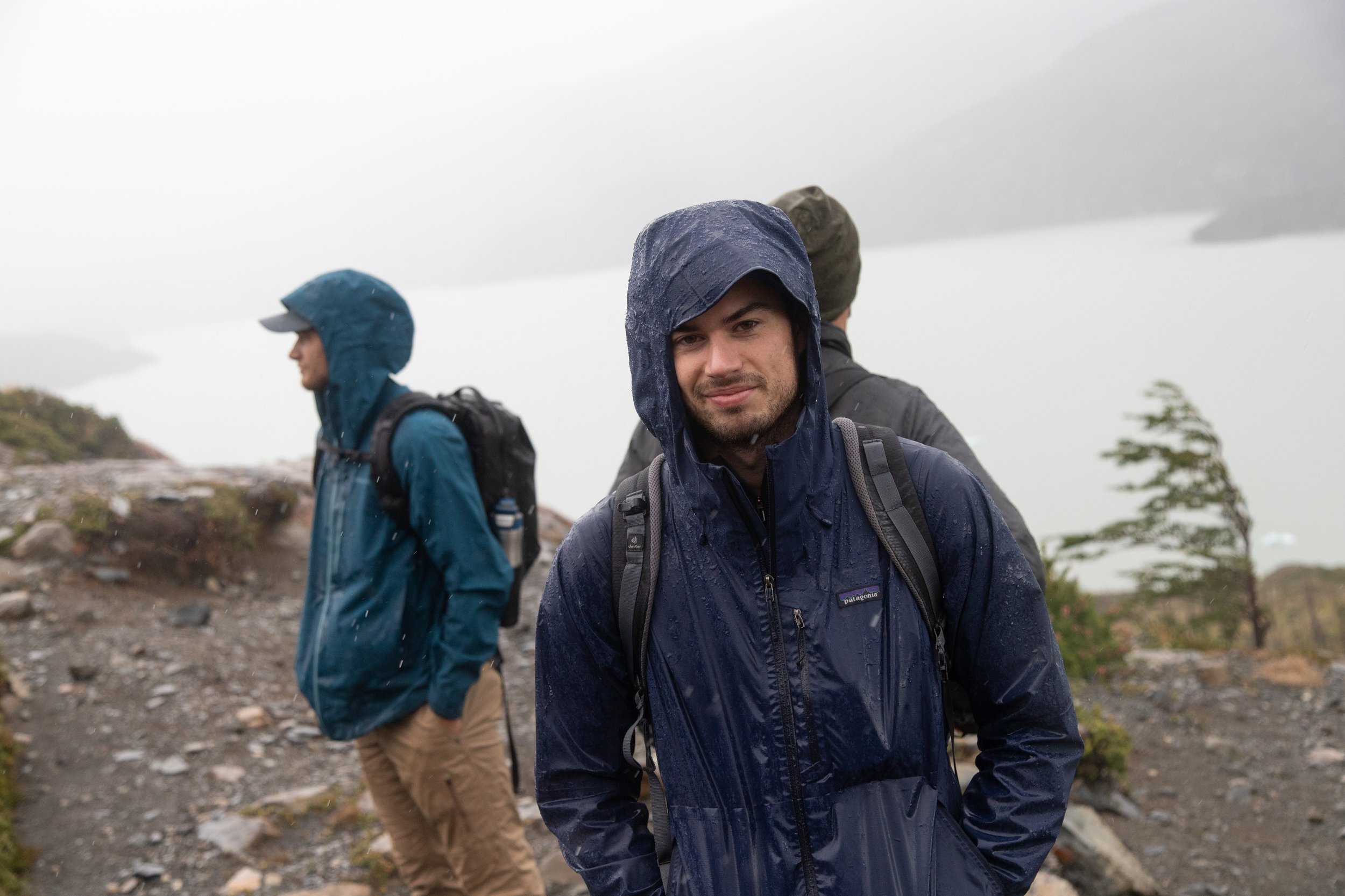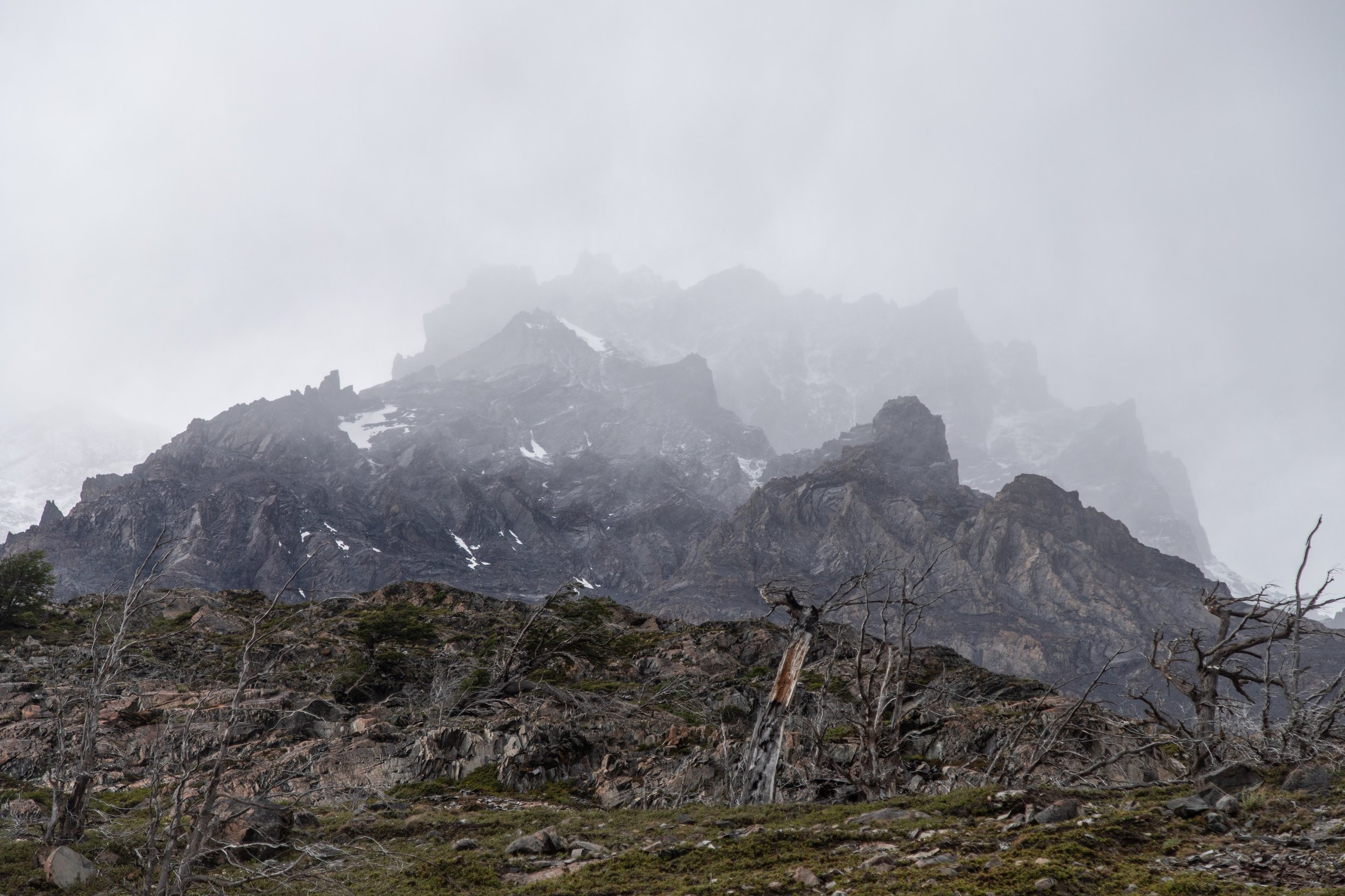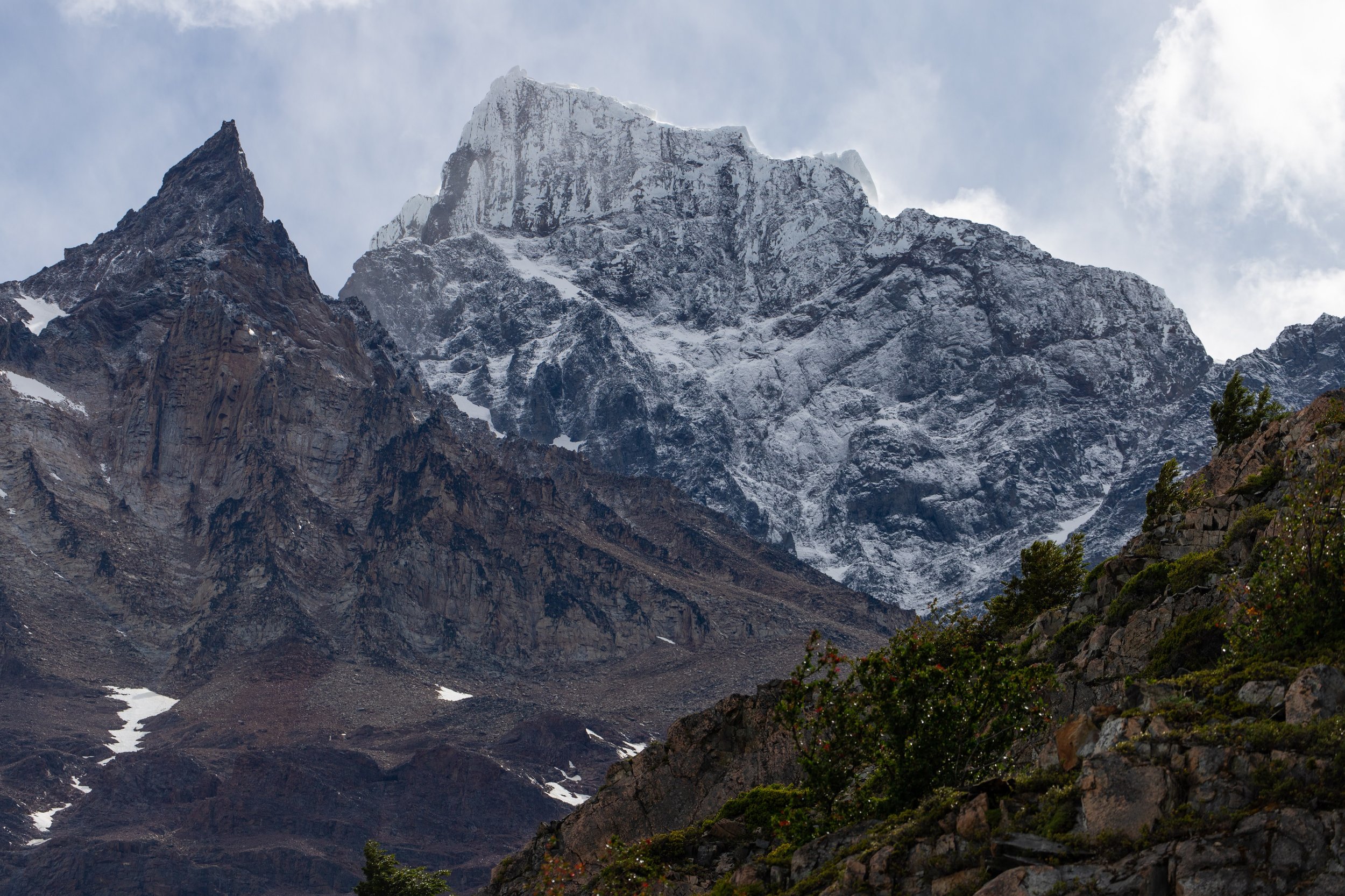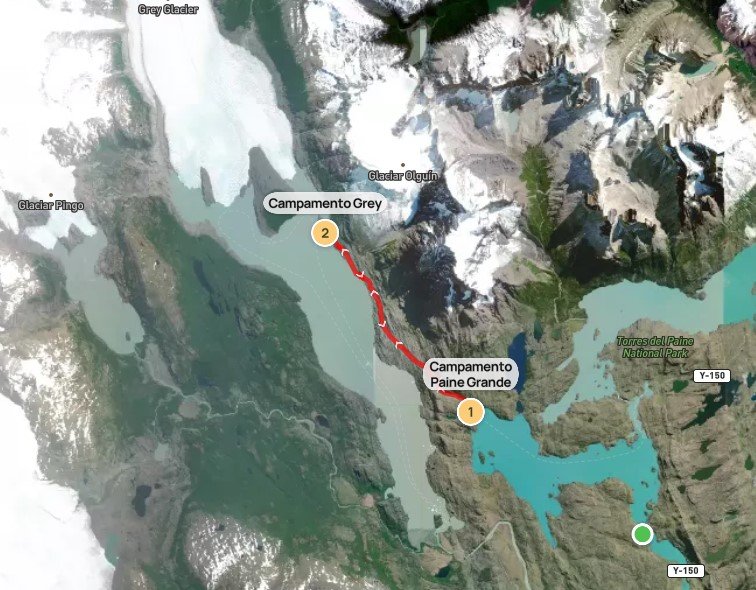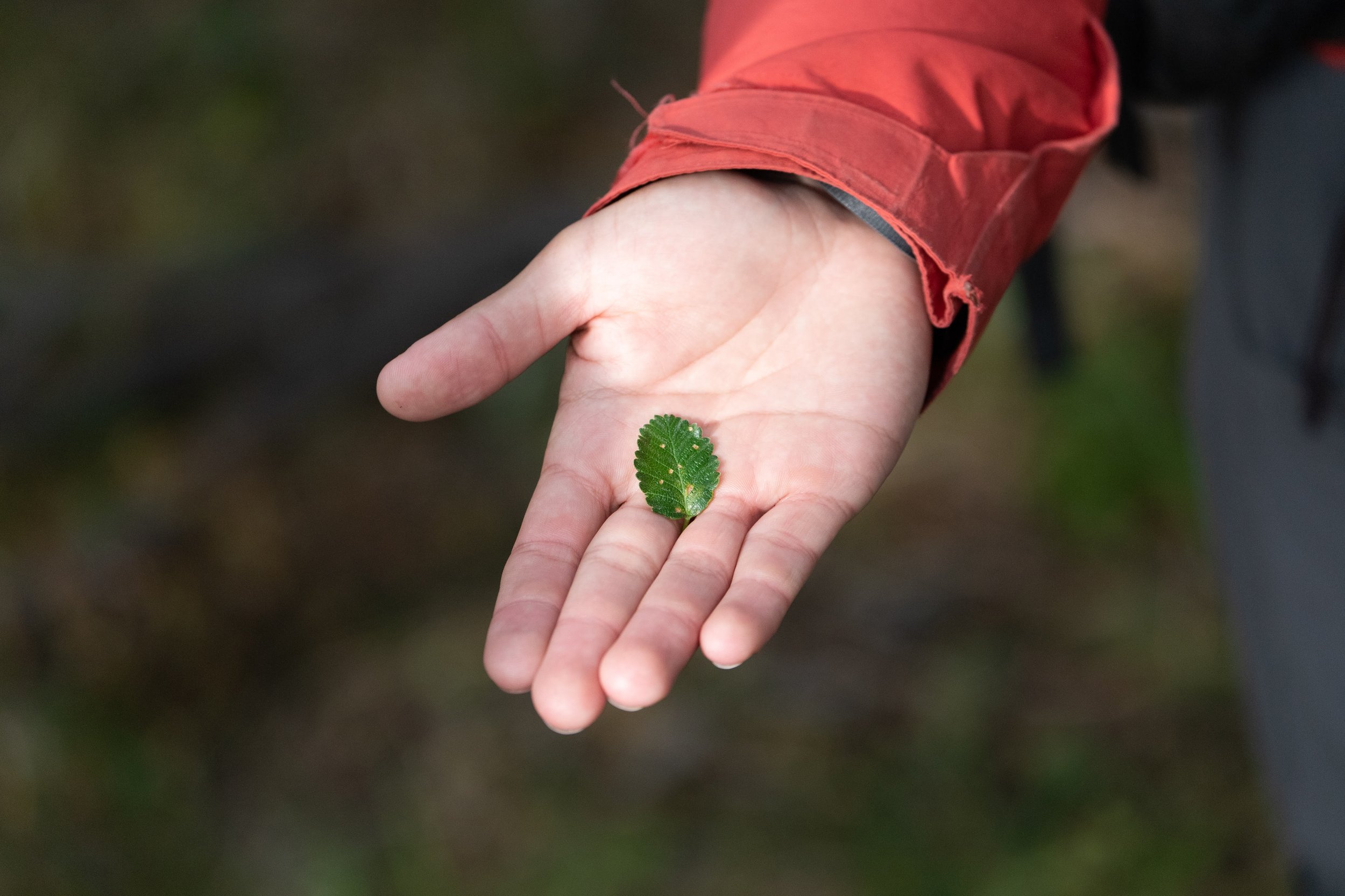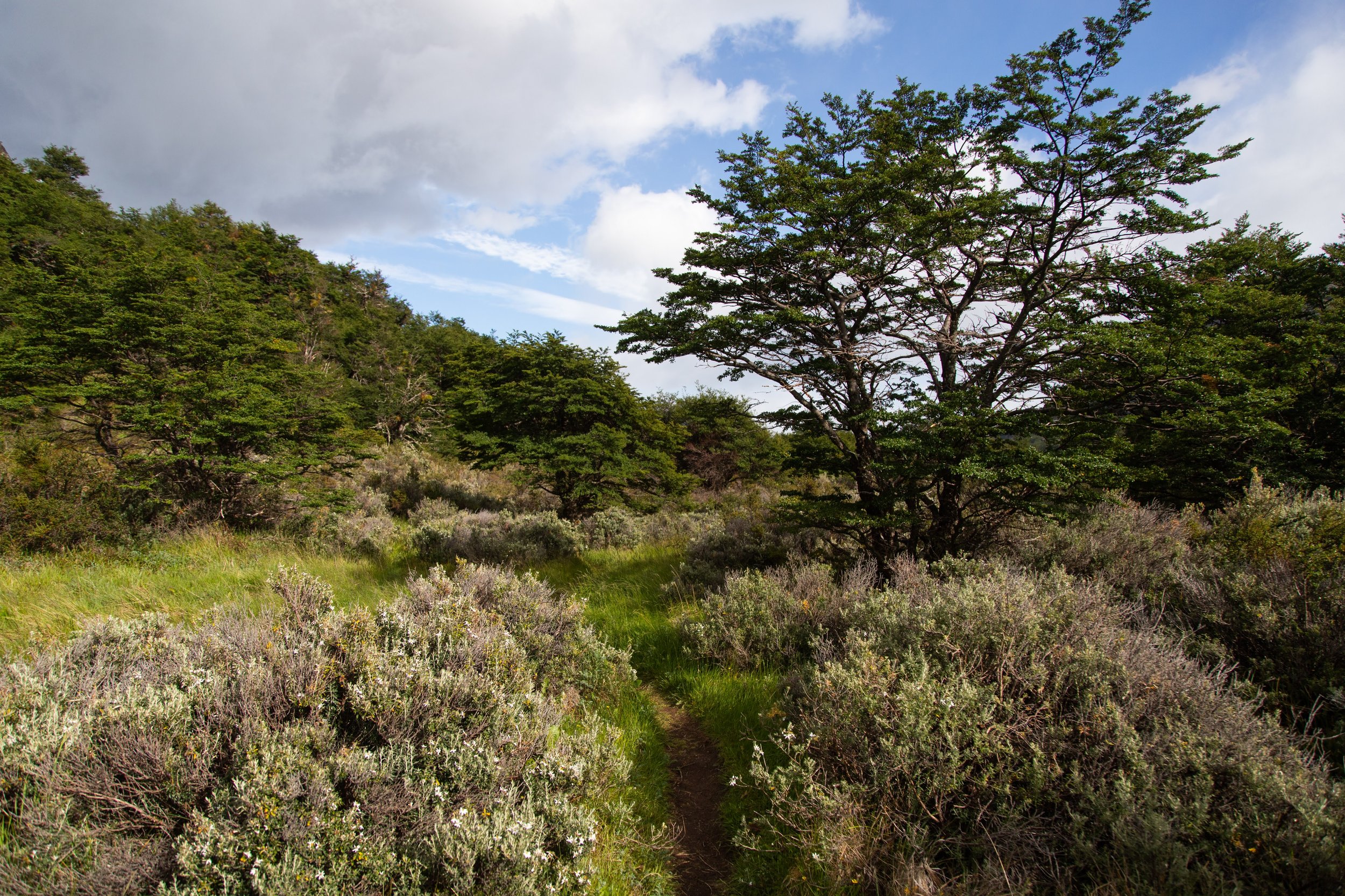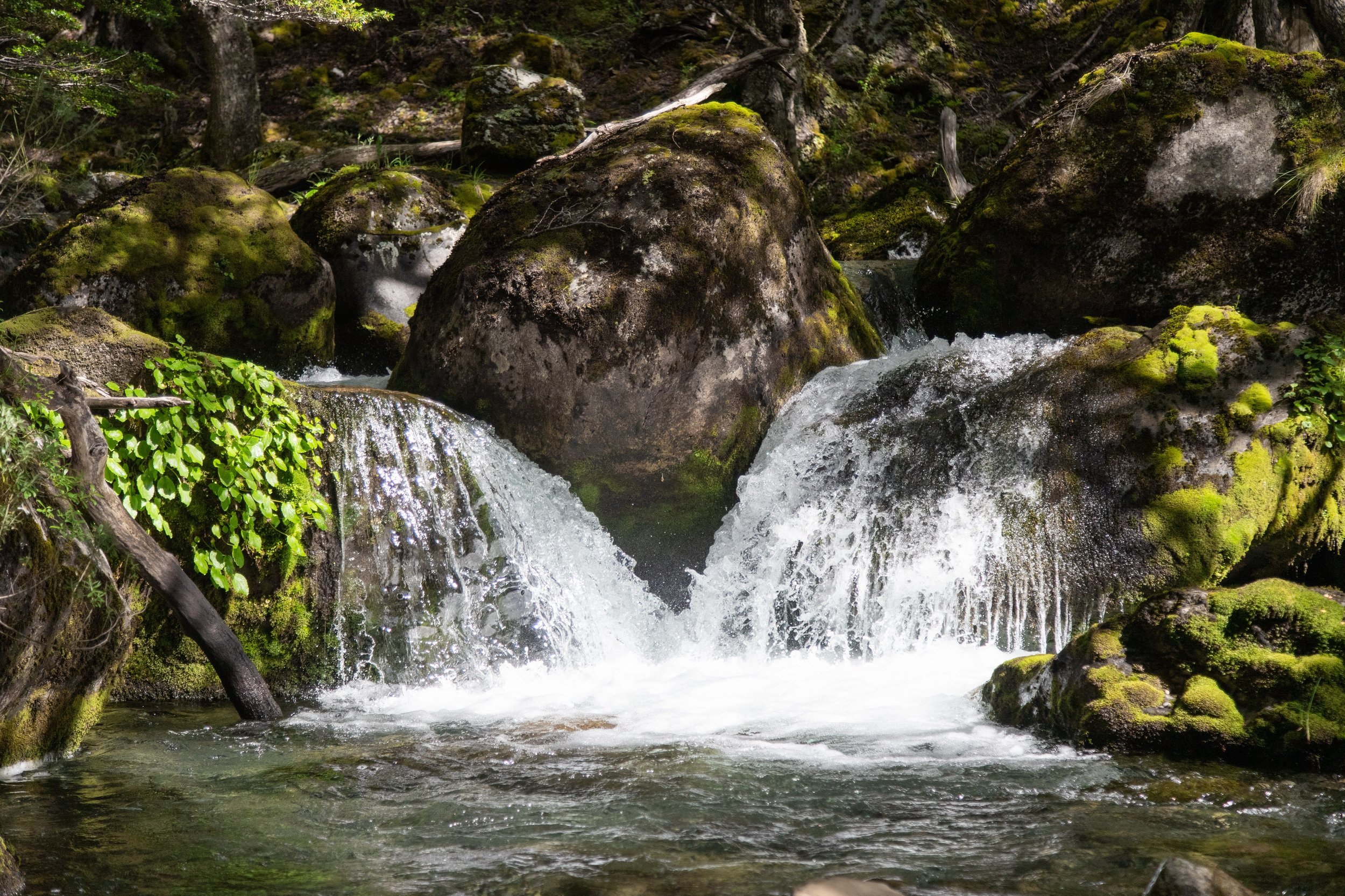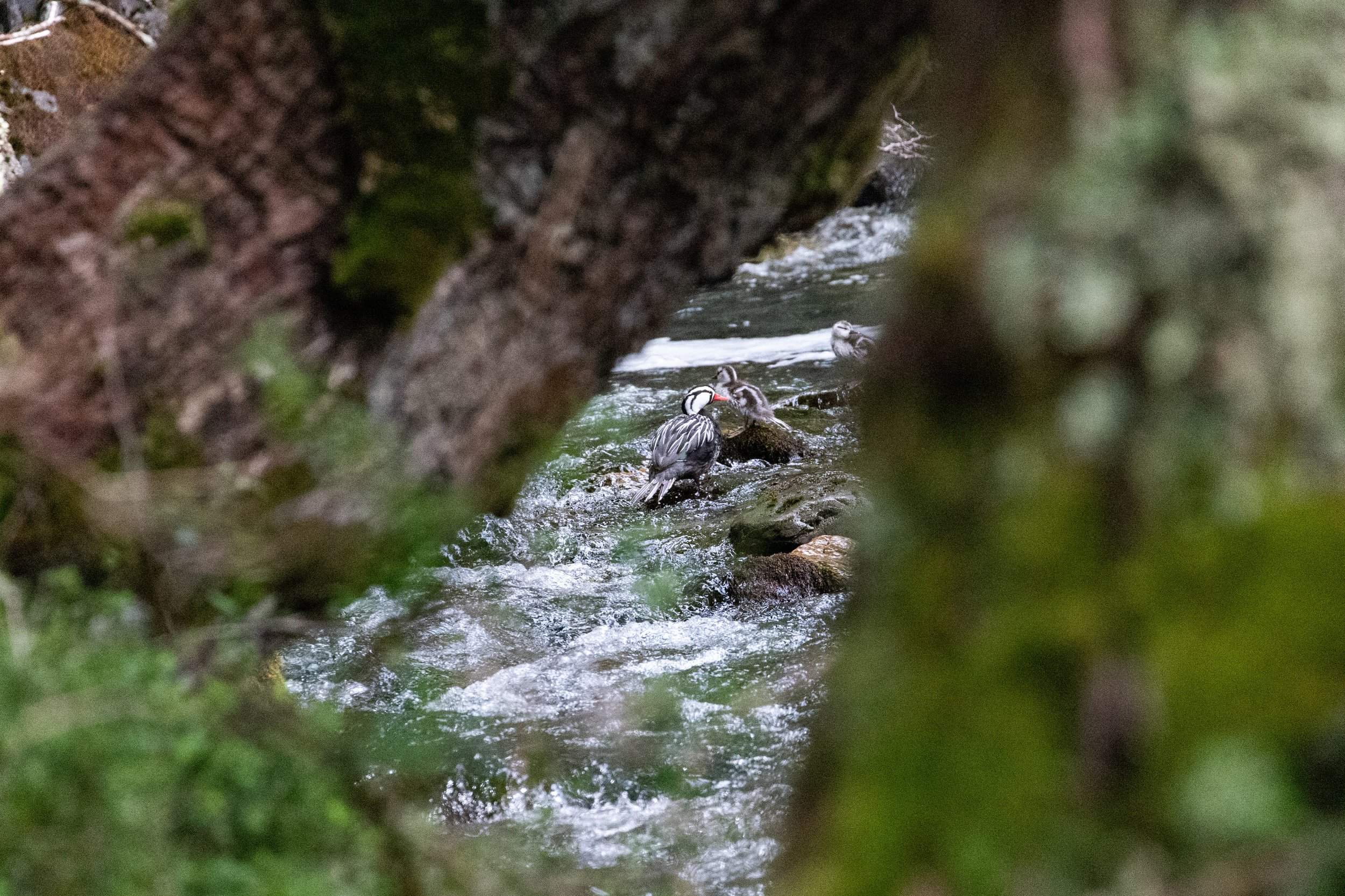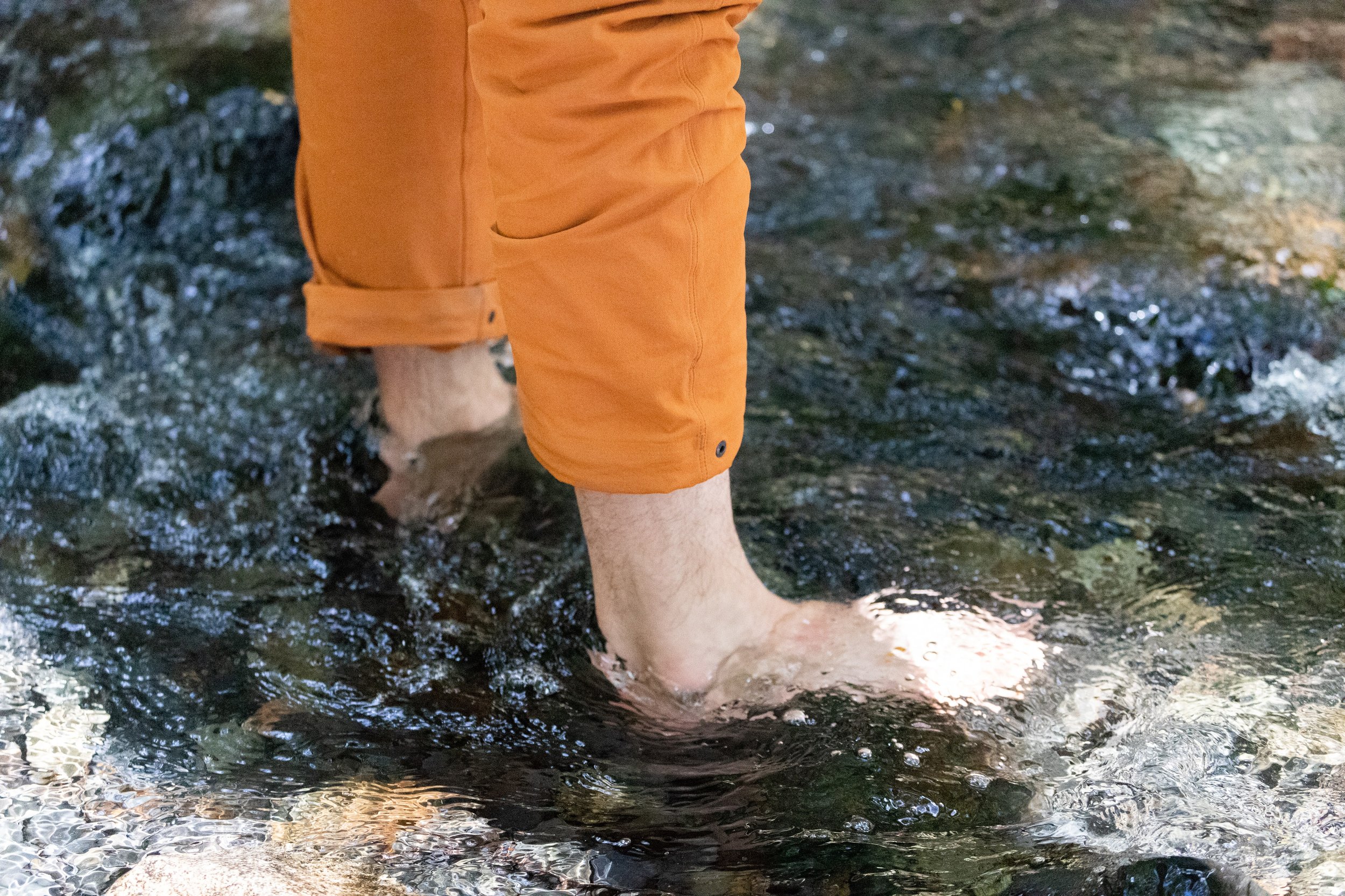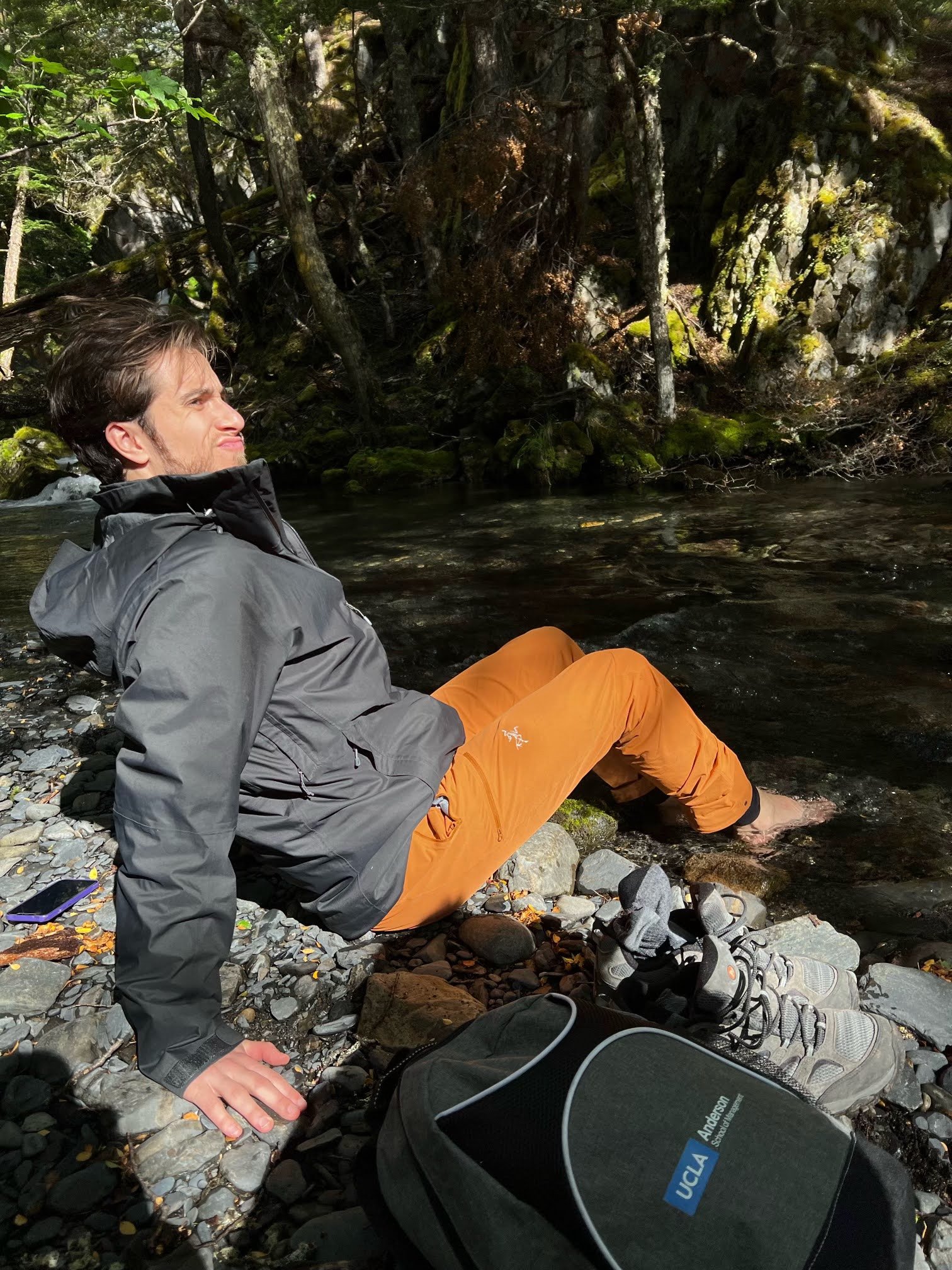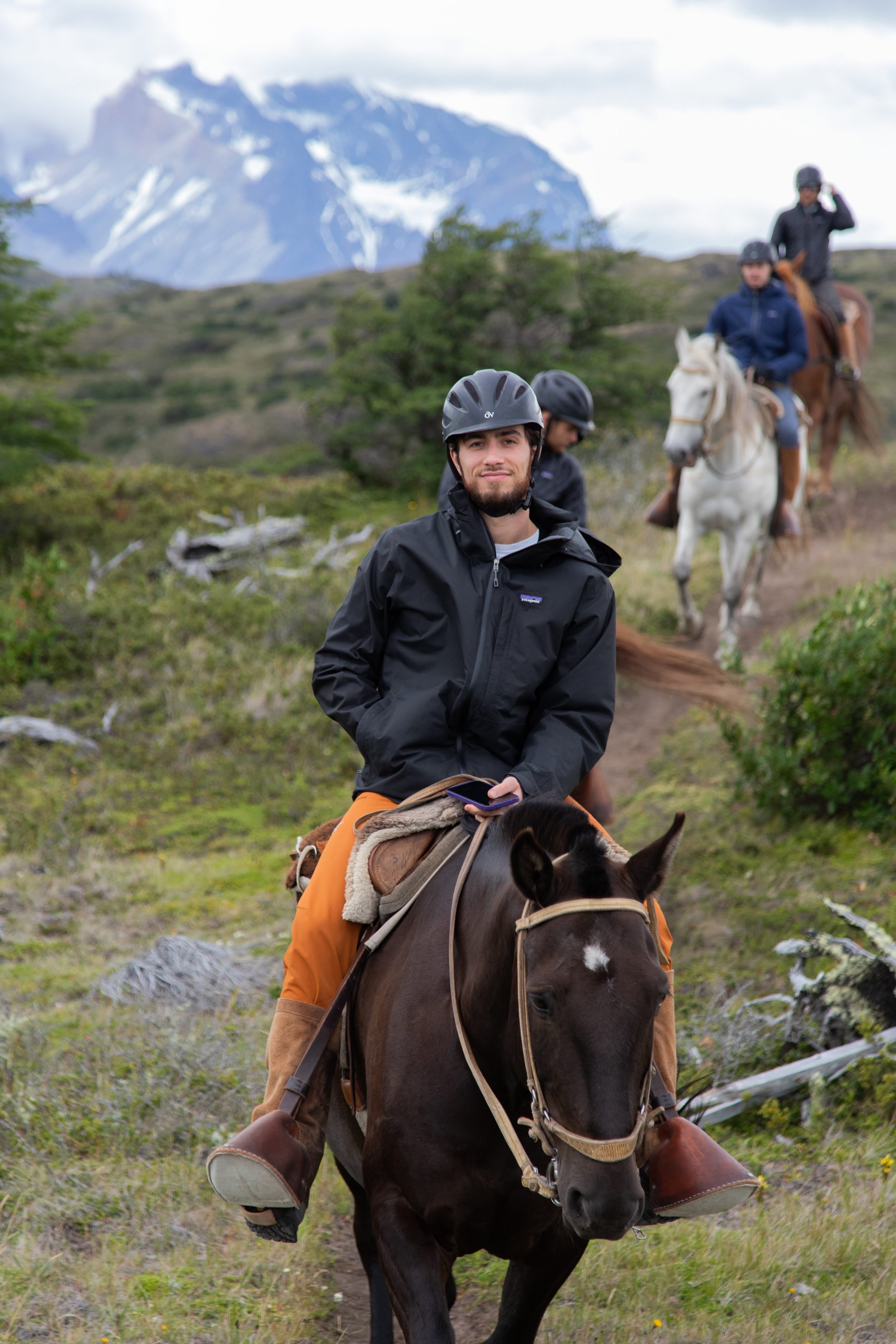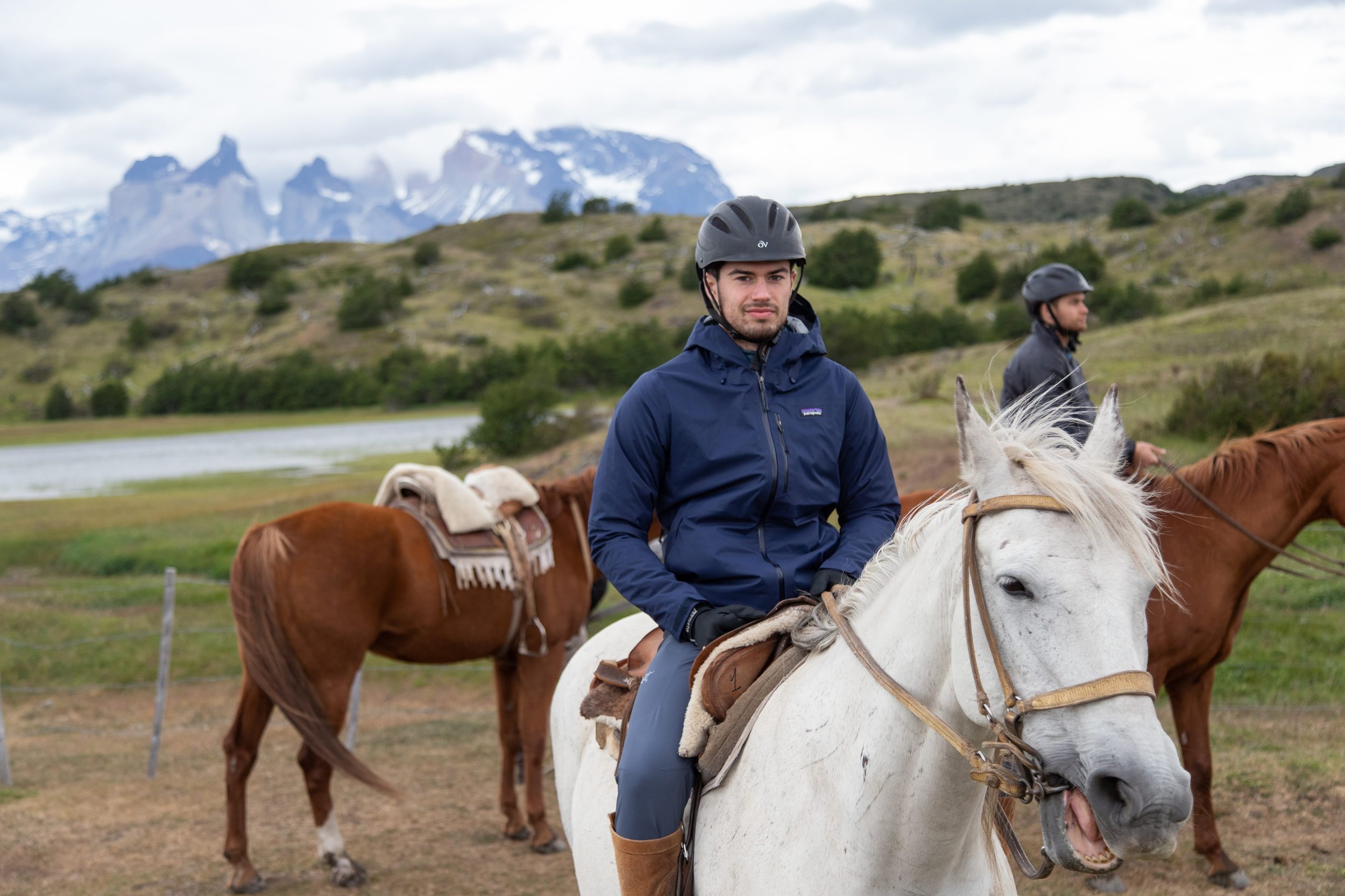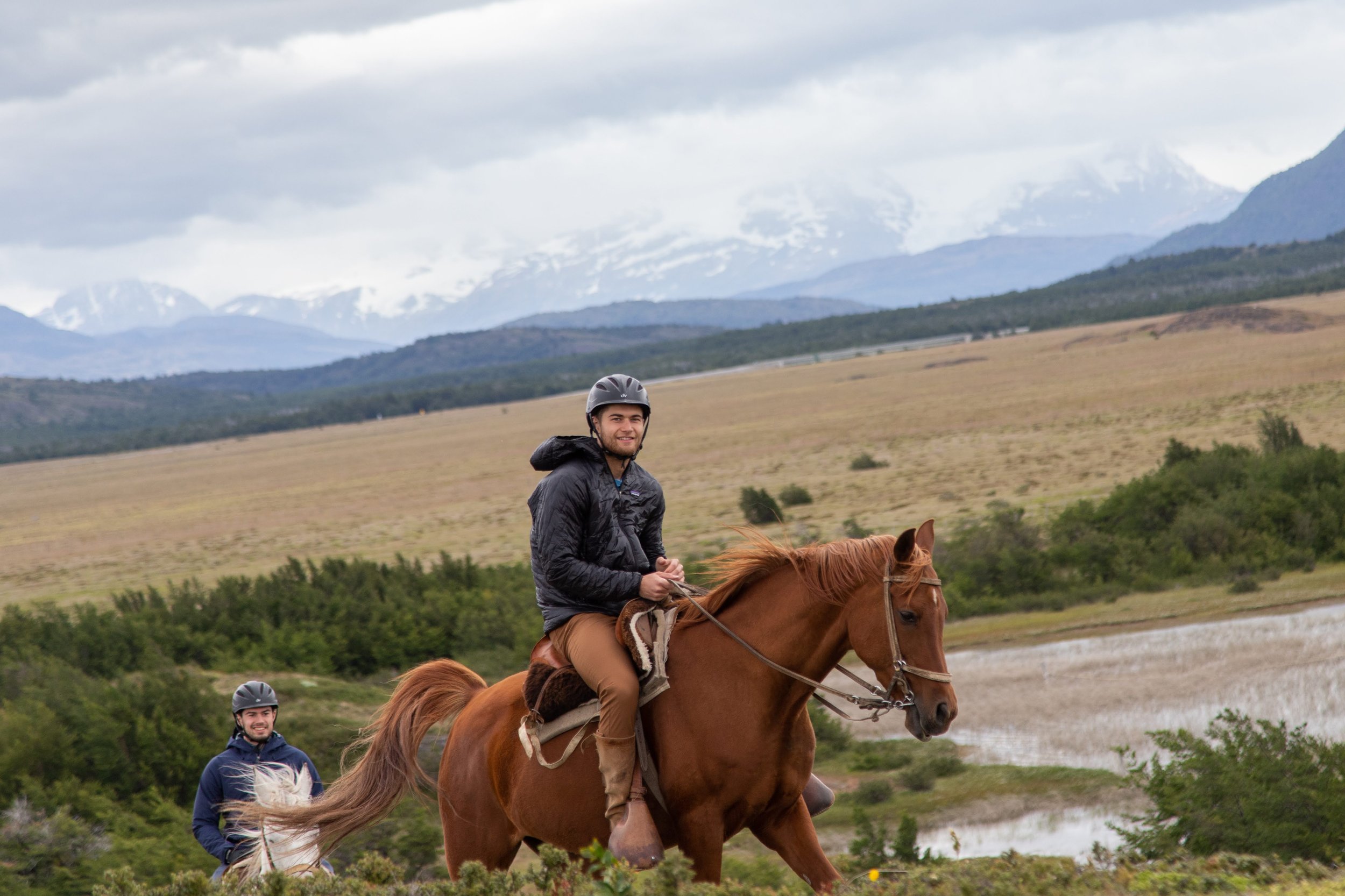S. American Advent — Part Two: Patagonian Winds
Achy from the prior day’s wine tour, we arrived at the Santiago airport before the sun had risen. A few hours later we were airborne on Sky Airline Flight H2421, which bore due south, quickly stopping in Puerto Montt before alighting in Puerto Natales.
We then boarded a van, traditional Chilean music accompanying the bumpy and winding ride that unfortunately made me carsick. Not that it made a huge difference, as all I’d have done in either case is look out the window. We passed open green fields, then carved past forests and Cerro Tenerife, before finally reaching Lago el Toro, from which we could see the Cordillera Paine, a view that would become our constant companion.
The moment we debarked at the doorstep of our hotel, the Explora, I felt much better. A group of hotel employees greeted us with smiles & waves, at which Johnny remarked: “White Lotus season 3?” Stepping inside felt like stepping onto a boat, albeit a stable one. Our hosts promptly shepherded us into the main lounge area, along with many of the other 80 guests who’d arrived that day, where a guide sat with us to help plan our activities over the next five days.
First up: a catamaran ride starting within the half hour. We wolfed down a soup & salad — finishing the latter before they’d even brought out the dressing — and immediately walked out to the dock.
At that moment, I realized how overwhelmingly tired and unsettled I felt. I wanted nothing more than to rest. So I let the rest of my family go, watching their boat depart from my room’s window. After all the movement of the preceding days, I needed to slow down a bit and put an end to feeling like a chicken with my head cut off.
After a hot bath and a few aborted attempts at sketching the mountains, I strolled around the hotel to get my bearings. It was stationed right on a small waterfall, through which H2O flows between glacial lakes. I’d heard the weather here can be unpredictable, but today it felt welcoming, so clear and calm it was.
By dinnertime, I felt fully acclimated. We sat in the downstairs of the two-story dining room, every table of which had a mountain view. It was hard to stop staring outside, especially as clouds slowly gathered over the uppermost peak.
We began our meal with guanaco tartare. When in Patagonia, I guess.
Feeling inspired by our drive and a little miffed by the neverending Phil Collins playlist, we asked to change the music to something “more Chilean.” And so it stayed until Christmas Eve.
My dad glanced at another table a few times before remarking: “that is totally the White Lotus family.” Indeed, as in the show, the whole crowd here was quite affluent, not to mention that every single guest spoke English. This sort of exchange was not exactly atypical:
Guide: “Where are you from?”
Guest: “America”
Guide: “You know this is America too…”
Before going to bed, Johnny found time to work on the puzzle our grandmother had sent us for Christmas and Ray found time to make a real sketch of the mountains. I was in bed by 10pm — in other words, before the sun set. Couldn’t wait for that though; we needed to be up early for our first hike.
By 7:30am, we’d pushed off from the dock on the same catamaran as the day before, crossing Lago Pehoe to Refugio Vértice Paine Grande and the day’s trailhead.
After a quick stretch, (which, as you’ll see, later proved invaluable), our group — the five Seebecks, the Kohn family (parents Victor & Lisa and daughters Lauren & Gaby), and our guides Martin & Rodrigo — began the 7.7-mile hike towards Grey Glacier.
As we began our ascent, we picked a few chaura and calafate berries to nibble on while passing scorched, dead trees, prompting Rodrigo to tell of the fire a tourist had started 11 years ago by lighting a piece of toilet paper on fire only for it to fly out of his grasp. Nine days later, 40 thousand acres had burned. The Explora itself might even have perished if not for a sudden change in wind.
Not quite an hour into the hike, it started drizzling and then pouring. We donned our rain gear and pressed on.
Our guides helped distract us from the cold rain with more stories. For instance, how five years ago a German woman got separated from her group while using the bathroom and was never seen again. Or how the abundance of lichen on the trees indicates that the air is fresh. Both facts emphasized to me just how remote we are.
Within an hour, the wind had cleared out the rain clouds and the sun peeked back out, prompting us to de-layer. By now we’d reached Lago Grey and hiked along (yet high above) its shore.
We could see little in the lake besides chunks of ice that had broken off the glacier. Then I spotted a tiny speck that I thought was a bird but soon realized was a boat. “That’s the same ferry that will pick us up later when it does its afternoon trip. As long as we make it to the shore by 1:30. Otherwise we’ll have to walk back!” *laughs*
We were making good time though, so no need to worry about that.
Ray’s sketch of Lago Grey, complete with glacial chunks of ice
We stopped at a stream to refill our water bottles with clean, cold glacial water — no iodine required. Then the glacier itself came into view, providing the foreground for the rest of our hike.
Rodrigo pointed out an island in front of the glacier. “See that? It used to be covered with ice. When the ice melted a few years ago, they found a body in a tent, and the police were everywhere to investigate and remove the body. Apparently a person had gone missing years before.”
By about noon, we’d made it to Refugio Grey, where we stopped for a lunch of guanaco charcuterie, pumpkin soup, and a canister filled with couscous, tuna, and veggies. After coffee & tea, we walked closer to the glacier for our final viewpoint.
Now we faced the full brunt of the cold wind, which raced off the ice so fast that it challenged my balance while thrusting chunks of ice towards shore. The point at which we stood had been covered by ice as recently as 1975.
That marked the end of our hike — now all that remained was to take the 1:30pm ferry, which would bring us up close to the glacier before crossing the lake and dropping us at our van, which would drive us back to the hotel. We all felt good — today had been the perfect first-day warmup for the longer hikes to come: one deep into the French Valley and another high up to Base Torres. We walked down to the shore of Lago Grey to wait.
Green Dot = Explora
Yet 1:30 came and went and still there was no boat in sight. About 40 people stood waiting, all of which had presumably made the same hike as us. First I heard mutterings about needing to walk back, but I couldn’t tell whether that was a joke or not. Then I saw Martin say something to Rodrigo that caused him to put his hands on his head in disbelief.
Our boat had been cancelled to due to the winds.
Apparently this happens only a few times a year. Yet today was one of those days. Our hike went from being 7.7 miles to over 15, the longest hike that many of us had ever done, including myself, with my longest having been around 14 in Idaho.
We started back, trying our best to keep our spirits high, yet unable to resist joking as we crossed a 3-person-max-capacity bridge: “Imagine if this broke. That would be bad!”
The entire group of 40 hiking back at the same time created a bit of a bottleneck.
The issue now, besides the hike itself, was how we’d make it back across Lago Pehoe. There was a public boat at 5pm but after that there wouldn’t be another until 6:30. So long as the winds permitted those boats to even go. Apparently, one time, a group had had to hike all the way back to the Explora, bringing their full-day trek to the length of a marathon.
We pushed as hard as we could to make the 5pm, but before we’d gotten halfway back, I started to feel a shooting pain in my right knee. This wasn’t the first time this had happened — presumably it’s some old football injury — but it had never happened with so much steep downhill hiking left to go. It didn’t help that I’d foregone hiking poles, or that the wind was strong enough to blow us off our feet, and nearly did a couple times. I squatted as low as I could to keep my balance, though squatting got harder and harder as my knee tightened up.
My dad started to slow down too. “I think I tore my meniscus” “What?? How do you know?” “I’ve torn the other one before and it feels the exact same.” He put on a knee brace, but was still faster than me. Johnny asked if he could get me poles from the guide, but I refused, too proud to admit either my mistake or just how feeble my body was. But when Martin caught up to me and asked the same thing, my need was too obvious (and dire) to deny.
By now there was no chance we’d make the 5pm ferry, much less the 5pm spa appointment we’d booked back at the hotel. Lol — to think how well our day could have gone! Though that sort of mindset was counterproductive at this stage.
Finally something turned our way: our guides confirmed via radio that the Explora catamaran had found a lull in the wind and made it across the lake. It would be ready to take us back immediately upon our return to shore.
The poles helped quite a bit, though by now I was well and truly limping down the mountain. It was no longer just my right knee that was the problem — the pain had spread to my right ankle to my hips to my lower back and through to my whole body.
The group took long stops ahead of me but I was far past being able to catch up. Most of the time I couldn’t see any of them. Person after person passed me by, though I wasn’t the only straggler, with two others from our group behind me. The pain was constant, but I had no choice but to keep pushing, head down to avoid any missteps. What felt like many hours later, I finally made it to the bottom.
Nothing — not even the whiskey neat nor the hot bath upon my return to the hotel — felt so good as stepping onto the boat and putting my feet up.
Once back in my room, I had special appreciation for its warmth and safety as I listened to the rain & wind batter the windows & walls.
Getting down to dinner was a mini ordeal, as I leaned hard against the railing to limp down one stair at a time. Once down, it was as if we were celebrities, with guests & guides alike walking up to us to say things like “you were the ones on Grey Glacier!?” Tomorrow the hike wouldn’t even be happening because of the winds.
As much pain as our bodies were in — especially me & my dad — we figured that a full rest day wasn’t in the cards. For one, we had only five full days here and had to take advantage. Add to that the fact that the best way to get in shape would be active recovery vis-à-vis a short hike.
As mentioned above, we’d been planning to occupy two of the next four days with the two other main legs of the W Trek: the French Valley and Base Torres. Each would be a full-day affair featuring over 10 miles of hiking. I wasn’t sure if I’d be physically able to do either, but I knew the only way I’d have even a chance would be to strike some balance between movement and rest tomorrow.
Martin recommended we try Pingo Chorrillo, which would only take the morning, leaving time for some relaxing horseback riding in the afternoon. At 5.6 miles, it would include only 700 vertical feet as compared to the 3400 we’d covered the day before, and would be less steep too.
Even so, I had doubts about whether my joints (and especially knees) could take it. But I woke up and got dressed and made it down the stairs much easier than the night before, so I figured I could at least make the attempt.
Rainbows lined our ride to the trailhead. The wind hit us the moment we stepped outside and started down the trail. Martin joined us again today, perhaps as ready as we were for the tranquility of a slower walk through lush terrain.
I did indeed feel pain with every step. Yet I kept thinking that all I had to do was keep putting one foot in front of the other. I thought how if the couple in The Salt Path could keep going then so can I. They’d set out on a 630-mile hike after being forced out of their home, and despite the husband’s being diagnosed with a terminal degenerative disease, they somehow got stronger the further they went.
Martin’s story about his time in guide training made us feel better too. He said that a month or two in, his feet were in such pain that, waking up in the morning, he could barely summon the power to stand up. But he did, and one day they stopped hurting, never to hurt again.
Our walk was as peaceful as could be — often silent save for the wind — as we didn’t encounter a single other person on the outbound trail. It reminded me of Castle in the Sky, when Pazu and Sheeta first arrive at Laputa and find nature flourishing in the idyllic remains of the great floating castle.
We stopped at our leisure, mostly initiated by Martin, who pointed out tiny leaves with detailed ridges, the paw tracks of a Geoffroy's cat (maybe even this one), and what almost became an eagle attack, as a big bird drifted closer and closer to a smaller bird before drifting away.
Our trail ran parallel to the Pingo River, starting out in grasslands exposed to the wind before we reached the forest and went under tree cover the rest of the way.
The hike felt very long according to my body, especially at the few downhills, which forced me to go very slow. Yet by mid-morning we’d made it to the waterfall, our resting point before heading back. Finding a spot to sit that didn’t disturb the bathing ducks, Martin implored that we try submerging our feet in the water — “it’s an anti-inflammatory and makes them feel softer” — so I figured why not. It felt alright at first, but soon got so cold it hurt. Yet when I took them out I felt the most wonderful release. I swear it put a pep in my step the whole walk back, as if the healing waters radiated all the way up my legs.
Still in the woods, an orange Chilean bee crossed our path. Upon stepping back under the open sky we saw a large black bird drifting high in the air. We thought it might be a condor, but it was a bit too far away to tell for sure. In general, Martin noted, the condor is distinctive for its long finger-like feathers and a white strip around its neck.
It was still very windy, so much so that I nearly lost my balance a couple times. I’m not sure whether that says more about the wind or about my legs.
As we walked between rows of bushes, a bird jumped from a branch onto the path and hopped directly towards me, getting almost close enough to touch before it hopped up onto another branch on the other side of the trail. Martin identified it as the Sierra Finch, which given my love for the book The Goldfinch (q.v. my t-shirt depicting the eponymous Fabritius painting), inspired my dad to posit that the bird must be a sign from my mom.
On the ride back, our van halted for a guanaco crossing: two adults and their kids. These were, of course, not only the first guanaco we’d seen on this trip but also the first we’d seen in our entire lives. The first living ones, at least.
After a few hours’ break that included lunch at the hotel (no guanaco tartare this time), we drove out to the stables for horseback riding.
The gaucho paired me with Tordo, named for a blackbird. He was one of the more competitive horses, always keen on getting to the front of the line, which to our gaucho meant “he’s a good horse.” That turned out to be a fair assessment, as he was reactive to my slightest touch and didn’t even try to eat that much.
My dad had been a little hesitant to ride, citing his experience in Spain over 15 years ago when he’d gotten saddle sores. Fortunately for him, we never went fast enough for that, essentially taking a nice stroll, a little up and down but nothing too crazy. Our group was full of beginners.
I saw a big black bird circling in the sky and this time — with its long finger-like feathers and white strip around its neck — it was unmistakable. Pointing up, I asked our guide: “Is that a condor?” “Ahh.. yes that is.” We all looked up.
They call the path we took Laguna Negra, and indeed we passed by many lagoons, and at one point passed over a river, at which my dad exclaimed: “I’ve always wanted to do that!”
Location of the horse stable
Back at the hotel, dining on king crab pie and beet risotto, we could see a guanaco staring down at us from atop the ridge across the river. Is he mad we ate his friend? I swear — no guanaco at this meal either. Besides, the hotel sources their guanaco-as-food from a totally different area.
Tonight, throughout the slow sunset, speckles & lines of light would hit the mountains at different angles with different colors at different times, as if the mountains were twinkling.
I thought to myself: hey man, we made it. Three years after we planned the trip, but we really made it.
As with Part One, most photos courtesy of Johnny!
In Part Three, our Patagonian journey concludes with an attempt to scale perhaps the most iconic trail in the park.


